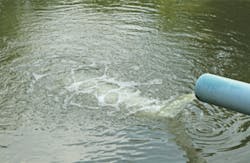It hasn’t been a good week for Toledo, Ohio residents, who stood in long lines at their local big-box stores Sunday morning to buy bottled water after the city’s mayor issued a tap water ban just after midnight Saturday.
The culprit?A massive algae bloom that turned the city’s source of drinking water, Lake Erie, toxic. Algae blooms—a heavy concentration of cyanobacteria, known as blue-green algae—grow in response to chemical changes in the water, presumably caused by fertilizer in runoff from farms. In Toledo, according to a Time Inc. report, "the phosphorus and nitrogen from these fertilizers runs into the Maumee River, which drains right into the Maumee Bay of Lake Erie, where Toledo is located." Summer heat also likely spurred the growth of this particular bloom, which made its way to the middle of the bay right where the water intake for Toledo’s water supply system is located, sucking in the blue-green algae along with the toxins it produces.
Two sample readings from the water treatment plant showed an excess of mycrocystin in the water, a neurotoxin that makes people sick, resulting in the ban and leaving residents to scramble for store-bought water to drink and brush their teeth. Boiling the water was not advised as it would only reduce the water volume, and actually increase the level of toxins.
The short-term solution?According to theTime report, Toledo’s conventional water treatment plan is a multistep procedure that removes dangerous pathogens and decontaminates the water in a variety of ways. To directly address the blue-algae toxins, the treatment plant used activated carbon to absorb and remove the toxins. As the carbon worked to rid the toxins, Mother Nature also helped, as the algae bloom moved away from the water intake location, most likely due to winds. After sample testing over the weekend, Toledo’s mayor removed the ban, with the support of the Ohio EPA, on Monday morning.
RELATED: How Changing River Chemistry Is Affecting Eastern U.S. Water Supplies
The long-term solution?Lake Erie water contamination is nothing new. In fact, a Time video report said the city of Toledo spent $3 million in 2013 and requested an additional $1 million for chemicals to treat its water supply.
Frost & Sullivan Energy & Environment Research Analyst Ankur Jajoo, who consults in the water and wastewater treatment industry, said the Lake Erie water contamination is certainly no surprise and is likely to be just the beginning of a nationwide trend impacting regions that have issues with outdated infrastructure.
“Retrofits and upgrades have traditionally been the norm in the market in recent years, but this is the wakeup call to start major investments to ensure parameters beyond the plant’s control are still up to the required standards," Jajoo said. "It is one thing to reduce the amount of phosphorous entering the lakes, but it is another to ensure a backup plan is available to prevent algae blooms.”
Currently, there is not a federal standard for blue algae in water. In the Time article that questioned experts at the EPA and Environmental Working Group (EWG), possible solutions suggested were creating buffers, like plants and trees that stand between farms and the water, which may help catch fertilizer chemicals before they get into waterways, therefore preventing algae growth. Or, farmers could also use less fertilizer, in theory, although there are no such usage regulations in place. Another contributing factor of concern here is climate change, which is creating warmer water temperatures that serve as a breeding ground for these toxic algae blooms.
“It does not bode well in modern times that clean drinking water is a problem still, more so that it is a problem that has gradually developed," said Jajoo. "A joint effort from all involved—from the municipalities to the farmers and regulators will be needed.”
Who do you think should be leading the way in water infrastructure and regulatory improvements for Lake Erie and other major water supplies? Join the discussion in Flow Control Magazine’s LinkedIn Group.


